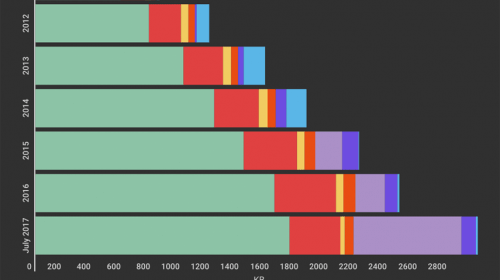With a population of over 51 million, South Korea is located in the southern part of the Korean Peninsula. The country is home to dramatic, mountainous landscapes, coastal plains, rolling hills and valleys. The country has gone through a great transformation, to become a technological powerhouse and a global provider of electronics and other high technology products and also vessels such as cruise ships.
South Koreans have a very urban-based lifestyle and the country is very technologically advanced with an educated and skilled workforce. The country is the world’s largest spender on R&D and is renowned as an innovator.
As a technological nation, one would expect to see high levels of smartphone adoption and networks that can accommodate this usage. South Korea boasts the highest smartphone ownership in the world and there is excellent 4G LTE coverage across the country. South Korea also has the world’s fastest Internet speed overall, and both mobile and fixed line infrastructure delivers high speeds. The country is also making its move towards 5G and network tests are currently being carried out in areas of Seoul.
Blind Spots in Need of a Service
South Korea is very well connected, especially in urban areas, where the majority of the population live, but there are still areas of population that are not yet connected to the Internet and this is something that can be addressed using satellite-based solutions. The South Korean government has placed great emphasis on the use of broadband for essential services such as e-government, e-health and e-learning and has used this to good effect. To take these services to those who do not currently have access in more remote locations across the country, satellite provides an ideal, cost-effective solution. BusinessCom is a leading provider of VSAT broadband services for areas that are currently not connected by terrestrial connectivity means. VSAT terminals are easy to deploy even in mountainous and inhospitable areas where it is impossible to put down terrestrial networks. They allow the full range of IP services, enabling communities to enjoy the benefits that broadband brings to urban areas.
For mobile broadband, BusinessCom can provide connectivity for rural mobile networks where Mobile Network Operators can struggle to access, bringing more ubiquitous connectivity in remote regions of South Korea. Delivery of 2G, 3G and 4G services is made easy and the infrastructure is completely independent of local infrastructure.
With the deployment of 5G on the cards in South Korea, satellite will also have an important role to play in terms of providing coverage in areas that are more difficult to reach.
Though South Korea is a very well connected and technologically advanced country, there is still some requirement for the delivery of services in the more hard to reach areas. Satellite-based solutions from BusinessCom provide easy, scalable and cost-effective access to the broadband connectivity that is so important to our modern world. BusinessCom can provide full assistance at every step to tailor a network that suits your requirements whether you are a business, governmental organisation or community.
Key features
Key differentiators of BusinessCom VSAT services in South Korea are:
- Broadband Internet access
- Toll quality VoIP and Videoconferencing with CIR
- Reliable SLA through FDMA and D-TDMA
- Star, Mesh and hybrid Star/Mesh topology networks
- Full support of accelerated VPN, CITRIX, ERM and other business applications
- Highly secure operation with optional AES embedded encryption
- Global C-Band coverage and sub-Sahara Ku-Band
- Landing at top tier redundant IP facilities in Western Europe and United States
- Sentinel-based QoS, bandwidth management and optimization platform





